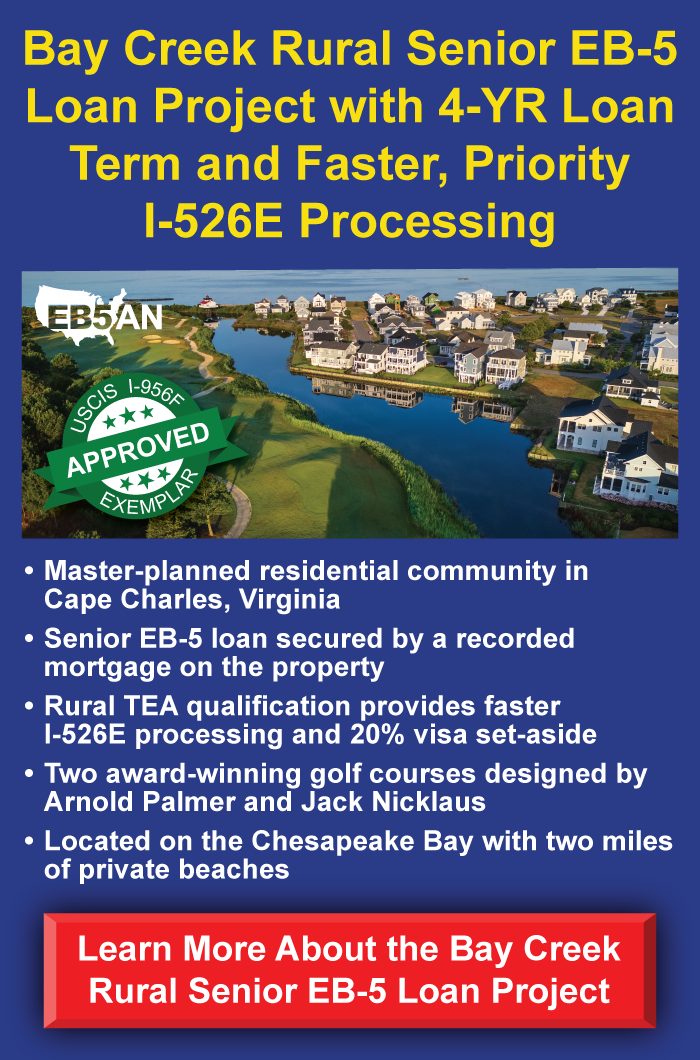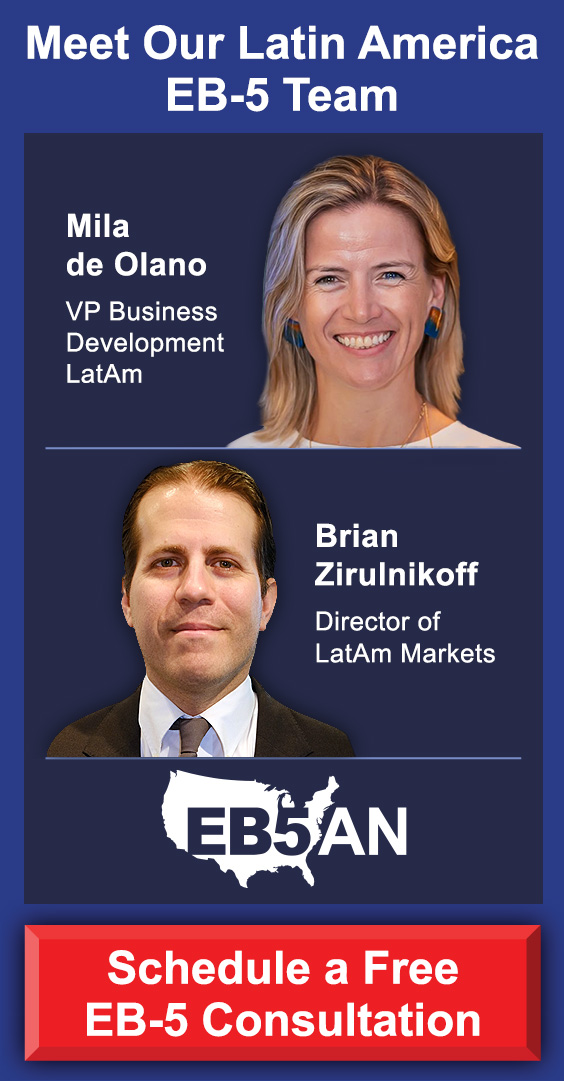The EB-5 program was designed to spur foreign individuals contribute to U.S. economic development by investing in a new commercial enterprise (NCE). In return for making a qualifying EB-5 investment, investors and their dependent family members (their spouses and unmarried children below 21) can receive EB-5 Green Cards.
To qualify for the EB-5 visa, prospective applicants must invest at least $1,050,000 in an NCE or $800,000 if the NCE is in a targeted employment area. The NCE must also create at least 10 full-time jobs for U.S. workers.
Although EB-5 investors can either invest in an NCE directly or through a regional center, almost all EB-5 investors favor regional center investments. U.S. Citizenship and Immigration Services (USCIS) data indicates that regional center investments have accounted for about 96% of all EB-5 investments since the inception of the program.
In this article, we’ll analyze the differences between direct and regional center investments and explain why most EB-5 investors prefer investing through regional centers.
EB-5 Investment Options
Why Most EB-5 Visa Applicants Prefer Regional Center Investments
- Passive Involvement
- Ease of Meeting Job Creation Requirements
- Reduced Risk Burden
- Flexible Investment Models
Partner With a Reputable Regional Center for Your EB-5 Investment
EB-5 Investment Options
There are two investment options prospective EB-5 investors can choose from: direct investment or regional center investment.
While both options have the same end goal of U.S. permanent residency, their requirements and processes vary in several important ways.
Direct Investments
Under the direct investment option, an EB-5 investor can either start a business or invest in a troubled one.
If investing in a business, the enterprise must create at least 10 W-2 jobs within two years. If investing in a troubled business, the investment must maintain at least 10 full-time jobs which would have otherwise been lost.
Notably, direct EB-5 investment requires active involvement on the part of the investor. The EB-5 investor must manage the day-to-day business operations and is solely responsible for ensuring the business remains viable, creates the required jobs, and maintains eligibility for EB-5.
If the company experiences a setback or fails before the investor receives their unconditional Green Card, the investor may lose their EB-5 status.
Regional Center Investments
A regional center is a USCIS-approved public or private entity that fosters economic growth by pooling funds from several EB-5 investors to sponsor large development projects.
For regional center investments, the regional center forms an NCE, and EB-5 investors subscribe as limited partners. The pooled funds are then invested in a qualifying EB-5 project that creates the required jobs for the EB-5 investment.
This investment option is most popular with EB-5 investors for several reasons.
Why Most EB-5 Visa Applicants Prefer Regional Center Investments
When the EB-5 program was launched in 1990, it didn’t immediately attract many investors. It only began to attract investors when the regional center program was introduced two years later. Since then, regional center investments have constituted an overwhelming majority of all EB-5 investments.
Below are some of the reasons EB-5 investors prefer regional center investments.
Passive Involvement
One primary reason investors prefer partnering with regional centers is because regional center investments require passive or minimal involvement on the part of the investor. Instead of the investor being directly involved, the regional center serves as the principal partner of the NCE and oversees its day-to-day operations.
The passive nature of regional center investments makes it easy for different categories of persons, including non-business-savvy investors and students, to participate in the EB-5 program. This route allows investors to pursue other areas of interest while seasoned professionals manage their EB-5 investments.
As a result, professionals seeking an EB-5 Green Card to advance their careers can pursue their career goals along with their EB-5 investment, and student investors can focus on their studies.
As with any investment, however, you must conduct thorough due diligence on the regional center and EB-5 offering before subscribing to ensure the safety of your investment.
Ease of Meeting Job Creation Requirements
Another major reason EB-5 investors favor the regional center option is the ease of job creation. Unlike direct investments, where only direct W-2 job creation counts, regional center projects can include direct, indirect, and induced jobs when calculating jobs created by the NCE.
This is because most regional center projects are large-scale real estate developments with significant material and construction spending. Construction and operational jobs related to development count as direct jobs. Meanwhile, the project’s spending on materials and local services constitutes indirect jobs, and employees’ spending on food and accommodations in the area constitutes induced job creation.
Because of these added job categories, such projects often create more jobs than the number required by their EB-5 investors, making it easier for investors to meet the job creation requirement.
Reduced Risk Burden
Whereas in direct investments, the investor bears all the business risks and is solely responsible for the success of the NCE, the risks are more spread out in regional center investments.
The regional center and project developer have vested interests in the project’s success and will naturally do their best to ensure it succeeds. Thus, the investor is not solely responsible for the success of the enterprise and is not the sole risk bearer.
Still, not all regional centers and developers take on the same level of risk, so thorough due diligence is essential to identify red flags and minimize project risks.
Flexible Investment Models
Regional center investments can be structured in two ways: as a loan or as equity.
Most EB-5 offerings are structured as loans. In these offerings, the regional center pools investors’ funds and loans them to the job-creating entity. Loan offerings typically offer increased financial safety and a more predictable repayment timeline but lower overall returns.
For equity offerings, the regional center again pools investors’ funds, but in this instance they are used to purchase interests in the project. Equity offerings largely benefit from higher rates of return, but the repayment schedule is much less certain.
Most regional centers have several EB-5 offerings in loan and equity investment models, allowing investors to choose the one most suitable to their goals.
Conversely, the choice between loan- and equity-based investment is almost non-existent in EB-5 direct investments. Direct investments are almost always common equity because the enterprise relies solely on the investor’s money and active involvement to succeed. This means that investors who might want the benefits of a loan offering likely can’t receive them through a direct investment.
Partner With a Reputable Regional Center for Your EB-5 Investment
Due to their added safety, increased flexibility, and lower time demands, regional center investments are far more popular than direct investments. Consequently, it’s safe to say a successful EB-5 application hinges on choosing the right EB-5 project and working with the right regional center, such as EB5AN.
EB5AN leads the industry in transparent practices and is committed to ensuring its investors achieve their immigration and financial goals. We’ve helped over 2,300 families from 70+ countries obtain their EB-5 Green Cards, and we can do the same for you. We offer our clients first-rate, low-risk EB-5 regional center projects with a 100% USCIS approval rate to date.
Book a free one-on-one call with our EB-5 experts to learn more about our EB-5 offerings.










